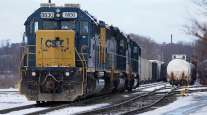Railroad Executive Hunter Harrison has Reputation for Success and Record of Cost-Cutting

A month ago, few people in Jacksonville, Florida, probably ever heard of Hunter Harrison. But the 72-year-old Tennessee native has been almost a legend in the railroad world where he’s spent more than 50 years.
He started out as a 19-year-old crawling underneath rail cars in Memphis with a can of oil. He went on to lead not one, not two, but three railroads, turning each around significantly and quickly.
Now he’s in the midst of discussions that could put him at the helm of CSX, the largest railroad in the eastern United States, third-largest in the country, and a fixture in downtown Jacksonville.
Shareholders won’t vote on that until this spring, but analysts have predicted the chances of Harrison taking over are very high. And those chances seemed to increase even more Feb. 21, when the company announced that CEO and Chairman Michael Ward and President Clarence Gooden would retire in May. A year ago, Ward had said he planned to work three more years.
RELATED: CEO of CSX to retire as Hunter Harrison negotiations continue
Harrison’s stature in the railroad industry is undeniable. He was named Railway Age’s Railroader of the Year in 2002, when he was chief operating officer of the then-recently combined Canadian National/Illinois Central system. And he received the award again in 2015 as CEO of Canadian Pacific.
Larry Gross, a rail expert with FTR Transportation Intelligence, put it this way: “In terms of a railroad operating manager, he’s about as good as there ever has been. His record is extremely strong.”
Think about that: “As good as there has ever been.”
Harrison’s resume and reputation have been built on his tenure at three railroads: Illinois Central, Canadian National and Canadian Pacific. At each one, costs went down and profits up. But the number of employees went down with the costs.
Articles written about him over the years continually refer to an almost evangelical passion he brings to the job. He invited employees out to his hunting camp for three days.
RELATED: CSX shareholders seen likely to make Harrison a $300 million man
“I can honestly say that we’ve had a lot of younger people come to a Hunter Camp,” one of his executives said in a 2016 Queens College study of Harrison’s tenure at Canadian Pacific, “and they see this 60-year-old with passion for three full days. They come out saying, ‘He’s got more passion than I do and I’m 40 years younger than him. I have to step up my game.’ ”
“He’s a formidable presence in the industry,” Gross said. “He’s not a shy individual. But the rail industry is replete with people like him, throughout its history.”
But he’s also done it with a plan, with what’s called precision railroading. With most railroads, each rail yard set its own work schedules, said Anthony Hatch, a railroad analyst. That often created clashing schedules, he said, which required too many people and too much equipment.
“But he wants the entire system run by a centralized headquarters and working more like a conveyor belt,” Hatch said, “with trains running seven days a week, 24 hours a day and exactly on time.”
The fact that Harrison usually reduces staff is more a reflection of efficient operations needing fewer people than staff reduction as a goal itself, he said.
Along the way, he’s raised jumping horses and is chairman of The National Horse Show Association of America. For those interested, his 33-acre horse farm near Palm Beach went on sale in December for $45 million. He has another one in Connecticut that was listed three years ago for $55 million.
Illinois Central was on the brink of bankruptcy when Harrison arrived there in 1993. But he quickly turned that around and when Canadian National bought it in 1998 for $2.4 billion, he become chief operating officer at CN and went to work.
An employee told Alberta Venture magazine about the first time Harrison stood up in front of 200 of the railroad’s top employees.
“He ended up talking for eight or nine hours straight, without notes or a slide presentation. He just got up there and spoke to the whole team about his philosophy and how we were going to run the operation. I remember thinking, ‘Who is this guy?’ ”
Employees were encouraged to take an economic share of the company through interest-free loans and matching funds to buy stock. But along the way, the company reduced its workforce by 11,000 employees and its service by thousands of miles of track.
“He has a very significant focus,” Gross said. “That means more miles out of the assets he owns. He likes to run longer trains, which means fewer trains if the volume is the same.”
Gross said Harrison is very selective about the customer base.
“He’s just focused on trying to align the customer base with how the railroad can efficiently provide service. If you want two cars one week and 200 cars the next, that doesn’t work for him. He’ll either drop customers or raise your rates.”
Revenue and profits both increased, and by the time Harrison retired from Canadian National in 2009, all of his competitors were using at least part of his methods.
Harrison set about raising horses after he left Canadian National, but in less than two years a plot began to unfold not at all unlike the current situation with CSX.
First of all, Harrison realized he wasn’t done.
“When you work in this business for 52 years, and walk away cold turkey one day with a gold watch and a party, there’s just a void there. I didn’t do a very good job of filling it,” he told Alberta Venture magazine last year.
And then billionaire investor William Ackman, through his Pershing Square Capital Management, starting buying stock in Canadian Pacific. When he had 15% of it, he led a proxy fight to oust the president and install Harrison in that top spot. It worked and in July 2012, when Harrison became president and CEO of what was considered the worst performing of the seven Class 1 North American railroads.
One of his first steps was to move the company’s headquarters out of a leased glass tower in downtown Calgary to the rail yards it owns on the city’s outskirts.
Over the past four years at CP, Harrison slashed nearly 7,500 positions from a workforce of 19,500. But the railroad’s operating ratio — expenses as a percentage of revenue — went from 81.3% to 58.6%. CSX’s 2016 operating ratio, by comparison, was 69.4%.
Along the way, Harrison made a bid to merge with CSX in 2014. Canadian Pacific was worth about $32.5 billion then while CSX was worth about $30 billion. When that didn’t work out, CP tried to purchase Norfolk Southern for $30 billion. That didn’t work, either.
But the railroad continued to improve. Its stock price went from $76 when Harrison took over to more than $214 in 2014 to $148.52 now.
By the time Ackman’s company sold its share of the railroad last year, it had earned a $2.6 billion profit on its $1.7 billion investment.
Harrison was due to retire from Canadian Pacific in June 2017, when he would become a consultant for the company at $1 million a year. But then news broke six weeks ago: He was retiring early and was forgoing a reported $89 million in benefits and awards in order to be released from his noncompete agreement. In other words, he wanted to run another railroad.
Meanwhile, Paul Hilal, Ackman’s Harvard roommate, had spent a decade with Pershing Square Capital Management and was the point man in the takeover of Canadian Pacific. But early last year, he left Pershing to go out on his own.
That’s when the final pieces became clear: Hilal had raised more than $1 billion for his fund, Mantle Ridge, to buy a stake in CSX and install Harrison in the top spot. He met with the CSX board early this month and among his proposals was that Ward retire and Harrison take over.
According to CSX, Mantle Ridge’s proposal included more than $300 million for Harrison, more than making up for the $89 million he gave up.
A shareholder meeting has been called for late April or early May to decide.
Feb. 21, the same day that CSX announced the retirement of Ward and Gooden, it also revealed that it would soon lay off about 1,000 management employees. But the company said that had been in the works well before Harrison and Hilal entered the picture.
In CSX, Harrison will find very different challenges than at his last two Canadian railroads.
“It’s just not because they’re Canadian,” Gross said. “They’re simpler systems, longer haul, more linear. CSX is a more complex network. If you look at it geographically, it’s more of a mesh than a string.”
Both Hatch and Gross said that CSX’s reputation in the industry has improved dramatically.
“It wasn’t necessarily viewed as the tightest organization,” Gross said, “but in recent years, it’s upped its game.”
“It’s much better,” Hatch said. “They have caught Norfolk Southern, their ancient rival. But U.S. rails are hurt by the 45% drop in their baseload commodity, coal, since 2008.”
The reduction in coal has been dramatic. CSX’s coal business dropped from $2.85 billion in 2014 to $1.8 billion in 2016. And while its stock has risen 29% to $47.99 since word came of Harrison’s involvement, Gross had this word of warning:
“What Harrison has not demonstrated is the ability to grow the business,” he said. “He can increase profitability in an existing portfolio, but not grow it.
“But no other railroad is growing either. The challenge of the next generation of railroaders is that they have to figure out a way to reverse decline in volume,” Gross said. “It’s not just a matter of increasing efficiency.
”That is not what you’d look at someone like Hunter to do.”
Distributed by Tribune Content Agency, LLC




